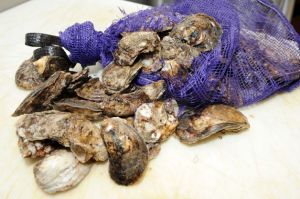Part one of our new occasional series on sustainability in our food production system focusing on the past, present, and future of New England’s fisheries.
The collaborative New England Food Vision Report, published by Food Solutions New England, considers the future of sustainable and equitable food production in New England. The report also suggests potential opportunities to increase production in the region over the next several decades, with a particular focus on fisheries.
Historical New England fisheries
Even before Europeans settled in New England several centuries ago, fish and shellfish were an important part of the regional diet. Particularly productive fisheries were—and to some extent still are—the Gulf of Maine, Cape Cod, Georges Bank, and Long Island Sound.
Up until the end of World War II, fishing fleets were typically smaller and could not bring in large hauls. But after the war, mechanization rapidly changed the industry. Motorized trawlers and gillnetters replaced sailboats and anglers. Catch efficiency and landing percentages increased as nets got tighter. These advances, however, came at the expense of successful long-term fish populations.
In 1976, the Magnuson-Stevens Fishery Conservation and Management Act was passed to stop foreign fishing vessels from fishing within 200 miles of the U.S. coastline. There had been a growing problem, especially in the North Pacific, with Russian vessels overfishing stocks that U.S. fishermen relied upon for their livelihoods. With a couple decades, however, overfishing in U.S. waters by foreign fleets had been replaced with overfishing by the U.S. fleet. In 1996, and again in 2006, conservation amendments were added to the Magnuson-Stevens Act to rebuild decimated fish populations. Today, 36 fish stocks around the country have been successfully rebuilt because of these measures.

(Surmountable) obstacles remain
Despite the recent gains due to the Magnuson-Stevens Act and stricter regional management, significant challenges remain to protecting New England fisheries from further loss, and enabling increased sustainable harvesting in the future. These challenges include:
- Overfishing of already-depleted species
- Closure of shellfish beds due to bacterial pollution from stormwater and sewage runoff
- Climate change-enhanced migration of regional species
But as the Food Vision suggests, changes in common practices can increase sustainable seafood harvesting in New England.
- Protect keystone species, as well as spawning and nursery areas, through activities like dam removal and fishway construction.
- Unintended bycatch could be used as food products, rather than wasted
- Encourage bivalve aquaculture in open water, to help maintain water quality as they filter water and balance nutrient levels
- Consider how different uses of the marine environment will impact fish populations, such as hydroelectric power, aquaculture, recreational boat traffic, and off-shore wind projects
Both our ability to enjoy delicious seafood and the integrity of the food web depend on wise management, including strong federal laws like the MSA.
